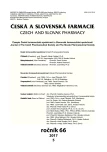Idiopathic thrombocytopenia refractery to therapy of cyclosporine A in clinical practice – case report
Authors:
Lucia Schwarzová; Zdenko Pirník; Natália Štecová
Published in:
Čes. slov. Farm., 2017; 66, 233-237
Category:
Overview
Primary immune thrombocytopenia (idiopathic thrombocytopenic purpura; ITP) is an autoimmune disorder characterized by isolated thrombocytopenia without abnormalities in the erythroid and myeloid/lymphoid lineages. The incidence of ITP in adults is estimated at approximately 1.6–3.9 per 100 000 persons/year. The aim of this study was to analyze a case report of a patient with diagnosed immune thrombocytopenia (D69.3) resistant to cyclosporine A therapy as well as an evaluation of factors that could contribute to an inadequate response to cyclosporine A. The results show a multifactorial origin of thrombocytopenia and a possible effect on refractivity to cyclosporine A therapy caused by long-term smoking, MDR-1 gene polymorphism, genetic predisposition to autoimmune diseases, allergic reactions as a manifestation of hypersensitivity in the immune system, controversial compliance of the patient, overcome infections as well as impact of drugs taken.
Key words:
immune thrombocytopenia • refractery form • cyclosporine A • therapy • platelets
Sources
1. Lakshmanan S., Cuker A. Contemporary management of primary immune thrombocytopenia in adults. Journal of Thrombosis and Haemostasis 2012; 10, 1988–1998.
2. Cines D. B., et al. The Handbook First Edition. Immune thrombocytopenia. European School of Haematology 2011.
3. Penka M., a kol. Neonkologická hematologie. Praha: Grada Publishing 2009.
4. Mizutani H., et al. Mechanisms of corticosteroid action in immune thrombocytopenic purpura (ITP): experimental studies using ITP-prone mice. Blood 1992; 79, 942–947.
5. Kahan B. D. Cyclosporine. The New England Journal of Medicine 1989; 321, 1725–1738.
6. Emilia G., et al. Long-term salvage therapy with cyclosporin A in refractory idiopathic thrombocytopenic purpura. Blood 2002; 99, 1482–1485.
7. Vyse T. J., Todd J. A. Genetic analysis of autoimmune disease. Cell 1996; 85, 311–318.
8. Shiozaki H., et al. Autoantibodies neutralizing thrombopoietin in a patient with amegakaryocytic thrombocytopenic purpura. Blood 2000; 95, 2187–2188.
9. Gesundheit B., et al. Cyclosporin A in the treatment of refractory immune thrombocytopenic purpura in children. European Journal of Haematology 2001; 66, 347–351.
10. Neylon A. J., et al. Clinically significant newly presenting autoimmune thrombocytopenic purpura in adults: a prospective study of a population-based cohort of 245 patient. British Journal of Haematology 2003; 122, 966–974.
11. Simanek R., et al. Late spontaneous remissions in severe adult autoimmune thrombocytopenia. Annals of Hematology 2007; 86, 705–710.
12. Khawandanah M. O., et al. Autoimmune hemolytic anemia and thrombocytopenia attributed to an intrauterine contraceptive device. Transfusion 2015; 55, 657–660.
13. Súhrn charakteristických vlastností lieku. Equoral 100 mg. Štátny ústav pre kontrolu liečiv. Dostupné z: https://www.adcc.sk/web/humanne-lieky/spc/equoral-100-mg-spc-6549.html
14. Súhrn charakteristických vlastností lieku. Sandimmun Neoral. 100mg. Státní ústav pro kontrolu léčiv. http://www.sukl.cz/modules/medication/detail.php?code=0015641&tab=texts
15. Tesfaye H., et al. Cyclosporine use in miscellaneous clinical settings other than organ transplantations: Is there any evidence for target levels? Annals of Transplantation 2008; 13, 34–40.
16. Choi P. Y., et al. A novel triple therapy for ITP using high-dose dexamethasone, low-dose rituximab, and cyclosporine (TT4). Blood 2015; 126, 500–503.
17. Pasquale D., et al. Chronic relapsing thrombotic thrombocytopenic purpura: role of therapy with cyclosporine. American Journal of Hematology 1998; 57, 57–61.
18. Souček M., a kol. Vnitřní lékařství. 1. díl. Praha: Grada Publishing 2011.
19. Provan, D., Newland A. C. Current Management of Primary Immune Thrombocytopenia. Advances in therapy 2015; 32, 875–887.
20. Choudhary D. R., et al. Efficacy of cyclosporine as a single agent therapy in chronic idiopathic thrombocytopenic purpura. Haematologica 2008; 93, e61.
21. Daniel F., et al. Multidrug Resistance Gene-1 Polymorphisms and Resistance to Cyclosporine A in Patients with Steroid Resistant Ulcerative Colitis. Inflammatory Bowel Disease 2007; 13, 19–23.
22. Sipeky C., et al. Genetic variability and haplotype profile of MDR1 (ABCB1) in Roma and Hungarian population samples with a review of the literature. Drug metabolism and Pharmacokinetics 2011; 26, 206–215.
23. Abrams C.S., et al. Thrombocytopenia. Goldman’s Cecil Medicine. 25th ed. Philadelphia, PA: Elsevier Saunders 2016.
24. Agarwal A., et al. Fluconazole-induced thrombocytopenia. Annals of Internal Medicine 1990; 113, 899.
25. Bemt V. D., et al. Drug-induced immune thrombocytopenia. Drug Safety 2004; 27, 1243–1252.
26. Buck M. L. Drug-induced Thrombocytopenia. Pediatric Cases from the Medical Literature. Pediatric Pharmacology 2010; 16, 1–4.
27. Visentin G. P., Liu C. Y. Drug induced Thrombocytopenia. Hematology/Oncology Clinics of North America 2007; 21, 685–693.
28. Bangia A. V., et al. Ranitidine-induced thrombocytopenia: A rare drug reaction. Indian Journal of Pharmacology 2011; 43, 76–77.
29. Royer B., et al. Methylprednisolone-induced immune thrombocytopenia. Blood 2010; 115, 5431–5432.
30. Ahmed I., et al. Heparin induced thrombocytopenia: diagnosis and management update. Postgraduate Medical Journal 2007; 83, 575–582.
31. Reese J. A., et al. Identifying drugs that cause acute thrombocytopenia: an analysis using 3 distinct methods. Blood 2010; 116, 2127–2133.
32. Grosbois B., et al. Thrombocytopenia induced by angiotensin converting enzyme inhibitors. British Journal of Medicine 1989; 298, 189–190.
33. Teh C, McKendrick M. Ciprofloxacin-induced thrombocytopenia. Journal of Infection and Chemotherapy 1993; 27, 213–215.
34. Hasan A., et al. Treatment with rituximab in chronic ITP patients induces long-lasting responses in approximately 30% of patients but even these patients may relapse. Repeated Courses of Rituximab in Chronic ITP: Three Different Regimens. American Journal of Hematology 2009; 84, 661–665.
35. Cooper N., et al. The efficacy and safety of B-cell depletion with anti-CD20 monoclonal antibody in adults with chronic immune thrombocytopenic purpura. British Journal of Haematology 2004; 125, 232–239.
Labels
Pharmacy Clinical pharmacologyArticle was published in
Czech and Slovak Pharmacy

2017 Issue 5
Most read in this issue
- Herbs for increasing breast-milk production
- Idiopathic thrombocytopenia refractery to therapy of cyclosporine A in clinical practice – case report
- Active substances from marine organisms in clinical trials and practice
- Development of the composition of intramammary combined preparation based on silver citrate for veterinary use
